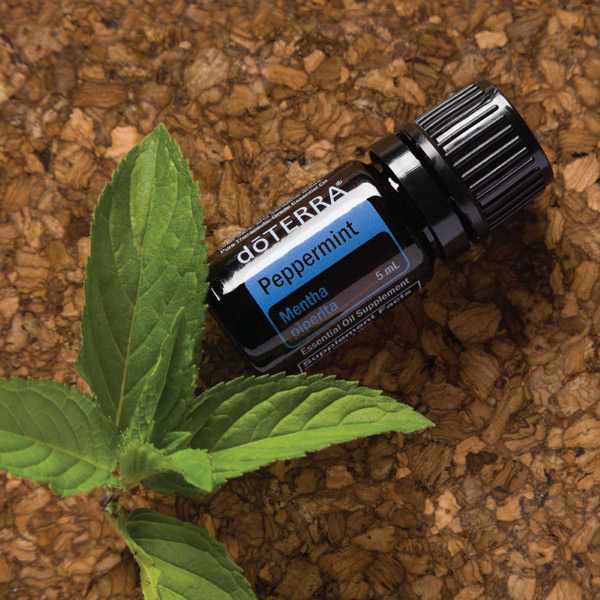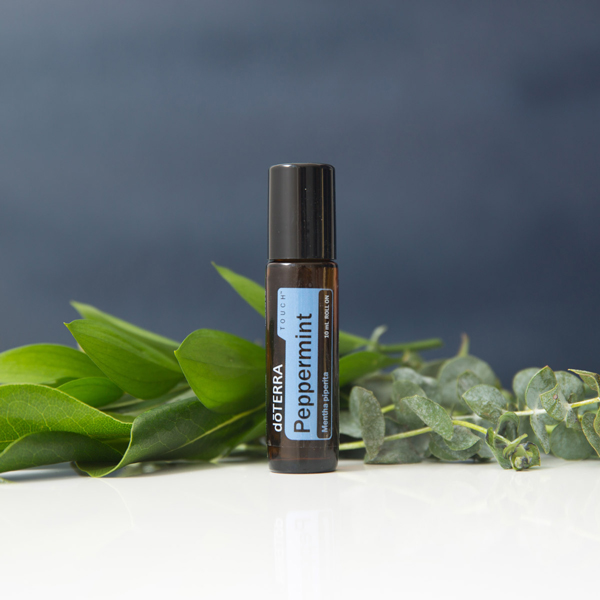Peppermint Oil Uses and Benefits
Essential Oil Spotlight
Essential Oil Spotlight


Peppermint Essential Oil Product Description
The peppermint plant is a versatile perennial herb that has been cherished since ancient times. The plant’s first recorded appearance dates back to 1000 BC when dried peppermint leaves were found entombed in ancient Egyptian pyramids.1 Throughout human history, this herb has been valued as a multi-purpose plant and an essential oil whose components are now used by cosmetic, culinary, and health industries around the world. When you use it internally, Peppermint oil is also well known for its ability to help alleviate occasional upset stomach and promote healthy respiratory function.* With so many facets and uses, it is no surprise that Peppermint oil continues to be one of doTERRA’s best-selling and highly-favored essential oils.
Where to Buy Peppermint Oil
To buy a pure bottle of Peppermint oil, visit our Peppermint essential oil product page.
Many essential oils available in the industry contain filler substances and contaminants that weaken the purity and power of the oil. However, at doTERRA, we know that a pure bottle of essential oil has the potential to change lives; that’s why doTERRA’s mission is to provide essential oils that are highly effective and free of additives and harmful contaminants. Our Peppermint oil is produced in the Pacific Northwest of the United States and other regions of the world. Through the partnership doTERRA has created with our growers, we receive only the highest quality Peppermint oil, which is then rigorously tested. We guarantee pure essential oils through the CPTG Certified Pure Tested Grade™ quality protocol. This protocol includes a series of strict tests that ensure the essentials oils we sell are free from filler substances or impurities—making the doTERRA essential oils you purchase powerful and pure.

Peppermint Oil Uses and Benefits
- Instead of reaching for artificially flavored gum or candy when you need to freshen your breath, look to Peppermint oil to do the job. Mix a drop of Peppermint oil with a drop of Lemon essential oil in water, take a sip, and swirl it around in your mouth for a healthy, refreshing mouth rinse. The most beneficial ingredient in this mouth rinse is menthol, a component found in Peppermint oil. Menthol has been used for centuries for its ability to cleanse and freshen. When you use a drop of Peppermint oil in your mouth rinse, the menthol is what gives it a fresh and minty kick. This powerful and fresh element is why Peppermint is found in many oral health products today. When using this Peppermint oil mouth rinse, you will experience a pleasurable, cooling feeling and you will walk away confident, knowing that your breath smells just as good as it feels.
- Peppermint oil is a culinary wonder and has been used to add a fresh boost to meals in kitchens all across the world. However, the use of Peppermint oil is not just limited to cooked dishes; it also makes a great addition to any smoothie. Try adding one to two drops of Peppermint oil to your favorite smoothie recipe for a burst of minty flavor. By adding the freshness of Peppermint oil to your morning smoothie, you can start your day feeling more refreshed than ever.
Peppermint oil also turns plain water into a cooling and refreshing treat. When the summer heat seems to overwhelm you, add one drop of Peppermint oil with a cut fruit like strawberries or limes for a deliciously infused water. Peppermint oil makes a healthy addition to any drink because it helps promote healthy respiratory function and clear breathing, and by adding doTERRA Peppermint oil to something as simple as the water you drink, you encourage healthy respiratory function in your body* while simultaneously changing up the flavor to your drinks.
- Peppermint oil can be used aromatically to enliven the senses and promote a feeling of energy. This powerful oil can be extremely beneficial on its own, but when you add the right combination of essential oils to Peppermint oil, the synergy of the combination of oils leads to even more benefits. For example, try placing one drop of Peppermint oil in the palm of your hand, add one drop of Wild Orange oil and one drop of Frankincense oil, and inhale by cupping your hands over your nose. This simple aromatic recipe is perfect for a mid-day pick-me-up.
Including Wild Orange and Frankincense in this Peppermint oil mixture adds to its aromatic benefits. Wild Orange carries a sweet and fresh citrus smell that is used to uplift the mind and body, while Frankincense is valued for its ability to promote feelings of relaxation. By combining these two essential oils with Peppermint oil’s soothing properties, the blend becomes an aromatic powerhouse that will have you feeling relaxed and energized for the tasks ahead.
- Try this do-it-yourself Whipped Peppermint Foot Lotion and show your feet how much you appreciate them. This is a simple and light lotion that includes natural ingredients like Mint oil and Tea Tree oil. After a long day, this DIY lotion can help you unwind and give your feet the delightful cooling sensation they need. For best results, try applying this lotion generously to your feet and then putting socks on before you go to bed. Whipped Foot Lotion with Peppermint oil will not only leave your feet smelling fresh, but it will also transform your sandpaper heels into a silky dream.
If you are looking for a way to share the benefits of Peppermint oil with your friends, try making and sharing this DIY Candy Cane Sugar Scrub. This festive sugar scrub helps exfoliate and moisturize the hands, feet, and body, and it makes for a great seasonal gift. Not only will the scrub produce soft and smooth skin, but its Peppermint oil base will provide a soothing sensation wherever it is applied.
- Being outside in the sun can be a great way to uplift your mood, but sometimes too much sun exposure can quickly end your fun. Try this homemade After Sun Soothing Spray to maintain healthy-looking skin after too much sun. This soothing spray is filled with three powerful essential oils that calm and soothe irritated skin. One of the primary oils used in this spray is Peppermint essential oil. Peppermint oil is a perfect after-sun essential oil for the same reason it is useful for oral care--its high content of Menthol. Tea Tree (Melaleuca) essential oil and Lavender essential oil are two additional ingredients in this DIY that will improve the appearance of skin.
- Looking for a long-lasting way to smell the sweet and minty aroma of Peppermint oil? Use this simple yet invigorating diffuser blend and enjoy this fresh aroma in your home, office, or classroom. To make this blend, combine two drops of Peppermint oil, three drops of Grapefruit, and two drops of Sandalwood into a diffuser. Using Peppermint oil in your diffuser will produce a cooling, invigorating vapor. Additionally, the grounding and mood-enhancing properties of Sandalwood and the uplifting benefits of Grapefruit will work well with the soothing and relaxing effects of Peppermint oil to produce an energizing and calming aroma that all will enjoy.
- Peppermint oil makes a great addition to many dishes, especially desserts. Try using this Black Bean Brownie recipe with Peppermint oil and put a nutritious and delicious spin on the traditional chocolate brownie. At first, making a sweet treat with black beans may seem strange or even off-putting, but don’t worry, black beans have a very mild flavor and are extremely rich, creamy, and full of protein. Once you venture out with this recipe, you won’t want to go back. To create an extra pop of flavor, add a couple drops of Peppermint oil for a delightful and refreshing flavor.
- The soothing components found in Peppermint oil make it a desirable oil for massages. Try adding Peppermint oil to your massage experiences and enjoy the pleasurable cooling feelings it brings to your skin while immersing yourself in its sweet and relaxing aroma. A great massage companion to Peppermint oil is Lavender. The combination of Peppermint oil and Lavender oil will produce optimal soothing feelings that will add to any massage. You can also try adding Peppermint oil to your shampoo or conditioner for a stimulating hair massage that will provide the pampering your scalp deserves.
- If you're finding more than your share of spiders or bugs in your home, Peppermint oil provides a perfect solution to ward off those creepy crawlers. Many bugs and spiders dislike the potent smell of Peppermint oil. Consequently, Peppermint oil is used as a home remedy to repel bugs naturally. Try placing one to three drops of Peppermint oil on a cotton ball and placing it in the corners of your bathroom, bedroom, kitchen, laundry room, or wherever you think these unwanted guests might be.
- Need to stay alert? Try Peppermint oil! If you or someone you know has trouble staying awake during the day and would like a natural method to feel alert, Peppermint oil used topically or aromatically can help. Because of the invigorating and cooling effects that pure Peppermint oil produces when it comes in contact with skin, Peppermint is an ideal oil for staying attentive and aware. In order to create this extra boost, place 1–2 drops of Peppermint oil on your fingertips and then rub your temples. The invigorating aroma of Peppermint oil will help give you the natural sense of alertness you desire when you need it most.
doTERRA Peppermint Oil Touch
doTERRA Peppermint Touch allows you to enjoy the benefits of our beloved Peppermint essential oil topically. All the essential oils in the doTERRA Touch® line are prediluted with Fractionated Coconut Oil and packaged in convenient roller bottles for easy application that smooths and hydrates skin while maintaining their purity and potency.
Repel irritating creepy crawlers naturally by rolling doTERRA Peppermint Touch on your neck, arms, and ankles before heading outside. Many bugs and spiders dislike the potent smell. Massage doTERRA Peppermint Touch on your chest and let the aroma promote feelings of clear airways. Break up a long workday by rolling doTERRA Peppermint Touch on your wrists and enjoy its fresh, minty scent. Menthol, the main chemical component in Peppermint, can have a cooling effect when applied topically. Roll doTERRA Peppermint Touch on your arms, neck, and shoulders for a soothing massage. Alternate rolling it on with doTERRA Lavender Touch for an extra calming aroma.

Would you like more Peppermint oil recipes and DIYs? Here are more of our favorite ways to use Peppermint oil at home:
DIY: Essential Lip Balm
DIY: All-Purpose Spray
DIY: Herbal Hairspray
DIY: Dry Shampoo
DIY: Essential Hair Wax
DIY: Shaving Cream
Essential Oil Recipe: Hot Cocoa
Peppermint Oil Fun Fact
Peppermint’s scientific name is Mentha piperita. In ancient Greek Mythology, Minthe (also known as Mentha), a nymph, was transformed by Queen Persephone into a sweet-smelling mint.2
Plant Description
Where does Peppermint oil come from? Peppermint oil comes from the leaves of the peppermint plant. The peppermint plant is a hybrid of water mint and spearmint plants. This cooling and relaxing herb is characterized by its square stem, dark green leaves, and small bunches of light lavender flowers. The peppermint plant can grow to be approximately 18–36 inches tall and can be found in a variety of different areas. Peppermint is known to grow best by streams or in wet locations with a lot of rainfall. Due to its specific water needs, Peppermint is cultivated in Europe, Asia, and North America.
Chemistry of Peppermint Oil
Main Chemical Components: Menthol, Menthone, 1,8-Cineole
The main chemical component in Peppermint oil is menthol. Menthol has a monoterpene backbone with an alcohol functional group. Menthol contains energizing properties that contribute to the overall energizing effect of Peppermint oil. Menthol is known to soothe the smooth muscle that lines the colon.* This relaxant property occurs due to menthol’s ability to keep calcium channels working optimally. The relaxing of colon smooth muscle reduces the movement of bowels, which eases occasional bowel looseness. Because of this effect, menthol is a main contributor to Peppermint oil’s ability to promote digestive health.* When Peppermint oil is swallowed, typically it is followed by a cooling sensation. This response happens because menthol activates the TRPM8 receptor, an indicator of cold.3* To learn more about the chemical components of Peppermint oil or other essential oils, visit the doTERRA Science Blog.

Oils that Blend Well with Peppermint Oil
Want to add Peppermint oil to your next diffuser blend? Luckily, there are plenty of essential oils that pair well with Peppermint oil, and can help you to make a lovely homemade diffuser blend. Peppermint oil blends well with Oregano, Marjoram, Cypress, Eucalyptus, Geranium, Grapefruit, Juniper Berry, Lavender, Lemon, Rosemary, and Melaleuca (Tea Tree oil) essential oils for diffusion.
If you're wondering where Peppermint oil comes from, watch this video to learn about the sourcing of Peppermint oil.
Caution
Possible skin sensitivity. Keep out of reach of children. If you are pregnant, nursing, or under a doctor’s care, consult your physician. Avoid contact with eyes, inner ears, and sensitive areas.
References
-
已複製到剪貼簿
- 下載


